Hospitality Brands & Twitter - Creating a Valuable Asset
By Doug O'Reilly & Oliver Sohn, Seventh Art Media
New York based hotelier Ian Schrager is widely credited as the father of the boutique hotel segment and proved that independent hotels can be highly successful. What is often missed is the equally critical role of the mother: the Internet. The online space has erased virtually all hurdles to inventory distribution - and social media has done the same with marketing and brand exposure. The key to every hotel's online business success is thus a function of two elements: Distribution + Attention.
While distribution is readily available in the online space, attention and exposure are not only more critical to a hotel's bottom-line success but also far more difficult to achieve. Consumers skip your paid media and invest into earned media instead. The purpose of Seventh Art Media's whitepaper series for the hospitality industry is to show hotels how to leverage today's communication culture, build high-performing marketing and communication assets, and maximize their social media ROI.
In our last whitepaper (available as free download at www.SeventhArtMedia.com ), we identified key opportunities for hotels to best leverage Facebook for brand amplification. Our conclusions and insights were based on the comprehensive analysis of 75 major hotel Facebook pages and the respective content performance measured over a time period of three months. We then identified and presented the keys to hotels gaining significant brand amplification via high-value content-based strategies.
In this whitepaper we focus on another mainstream social media channel: Twitter. Seventh Art Media has examined 135 hotel Twitter accounts and more than 120,000 tweets from November 1, 2010 to January 31, 2011 to identify the best opportunities for hotels to utilize this channel and assign an actual dollar-value to this marketing asset.
We strove to provide fact-based insights, judged in terms of their measurable value-add to a brand or property. As part of this effort, Seventh Art Media developed a value-based assessment method to rate and rank Twitter channels. What we found is that the most successful efforts by hotels to benefit from Twitter have created high-performing assets that pay for themselves many times over. The functioning of the highest performing brands and properties reveal a roadmap for how any hotel can build an asset that grows long-term customer loyalty, marketing efficiencies and direct conversions with little overhead cost and minimal organizational burden.
At a high-level the roadmap is built around the following key factors:
A long-term outlook is the first factor of success. Accounts that maintain engagement and have committed to slow but quality growth over time are now reaping the rewards of their efforts. Playing catch up or making a goal of rapid, but low quality, follower growth sees minimal returns on the investment.
Facebook and Twitter efforts are complementary, but should not overlap. On average, accounts with significant content crossposts between Twitter and Facebook significantly under-perform the ones that handle each channel separately.
Facebook is an exemplary platform for creating reach and amplification but it requires a strong content pipeline and is weak in creating sustained engagement. In contrast, Twitter is an engagement driven platform that requires care and commitment to build — but once it moves past a threshold level of engagement and volume it rapidly becomes a valuable brand asset.
Identifying ROI and objective performance metrics for hotels is an emerging capability. While Klout scores are a good place to start the evaluation of hotels' Twitter accounts they still miss many important dimensions that can help translate performance into ROI. A point to consider is the fact that follower growth in and of itself is a meaningless statistic. Quality followers will engage and interact with you via Twitter as well as amplify your content when relevant. Unengaged followers are a black hole for your content and add no value to your efforts.
Twitter offers a low-risk/high reward opportunity for hotels. The top five performing accounts in our study all have a current valuation of over $100k and they are all on a trajectory to continue to grow their values exponentially. In our estimation, hotel brands and properties at any level should be able to realize measurable positive ROI levels with proper goals, planning and organizational commitment in place. Once the asset is built, maintenance costs will drop in relation to returns. This means the time to invest is now.
Strategies for building out your social media effort via Twitter need goal-oriented planning from Day One. Once these are established you can build out a long-term roadmap to help overcome internal obstacles, establish an operational culture around commitment to the channel and begin to earn your way to the top.
This final point is key: Earn Your Way to the Top. Social media is earned media. You earn attention, engagement, loyalty and conversions by offering value to the audience. In Twitter this means engagement. In Facebook this means added value content. Beyond that, there are millions of possible combinations and avenues to reach your goals. This whitepaper lays out the roadmap for hotels to evaluate the possibilities and begin building an asset.
It is important to note that our review is not a comprehensive look at all hotel accounts on Twitter. We specifically chose to include accounts that were at least a year old (i.e. matured) or had shown strong recent growth. We also elected to exclude accounts identified as exceptional outliers, i.e. cases that the broader hospitality industry could not (or should not) emulate. These include properties with one-of-a-kind endorsements by Twitter influencers and hotels that have used a myriad of quick follower gimmicks with no regard to follower quality or long-term outcomes.
These forms of gimmickry often grab the headlines about Twitter because it is an open platform where numbers and trends can move quickly and spammers and bots can operate rather freely. But a long-term outlook can easily mitigate these issues and help brands and properties to effectively engage with their target market through the platform and build loyalty, engagement, amplification and, ultimately, conversions.
In fact, the long-term outlook is the first factor of success. As we developed our initial list of hotel Twitter accounts for our analysis, we noticed two phenomena that were striking: First of all was the number of “dead” accounts. These are accounts with several thousand followers that simply stopped functioning one day but continue to gain followers and mentions that are never responded to or acknowledged. The second phenomenon of note is the under-performance of highly hyped accounts.
We have all seen our share of “top 10” lists of hotel Twitter accounts. In performing our list building due diligence, we combed through dozens of Google results for top hotel accounts that various authors recommended we follow. What we saw was startling. These lists in total yielded only a few reasonably performing accounts and significantly more failures—including several dead accounts.
The simple fact is that these lists were mostly based on “potential” performance or the sampling of a few small things that looked interesting or different to the author. A quick look at when and where these accounts tapered off shows a fundamental disregard for a long-term commitment to building the channel. The combined insights from what drives success and what dictates failure for hotels on Twitter reinforce our most important recommendation: Build a long-term vision and set goals for what you want Twitter to do for your hotel brand or property. Easier said than done, but we hope the remainder of this whitepaper will help you expand the range of possibilities and enable you to develop creative applications in support of your goals. If you are successful, you will create a high performing asset that pays for itself many times over—an asset that can build long-term loyalty, marketing efficiencies and direct conversions with little overhead cost and minimal organizational burden.
Our conversations regarding Twitter with clients and colleagues both inside and outside of the hospitality industry often share a common theme.
Most people are still more focused on tracking media metrics than business results. Everyone knows how many followers they have, their Klout score and how many mentions they receive. Many go beyond these metrics and track reach and sentiment or have identified influencers in their particular networks. Those using integrated Twitter management platforms (HootSuite, TweetDeck) can delve deeper into click-throughs. These are all wonderful tools for managing accounts, followers and content streams, but none of them answers the primary question of “what is Twitter doing for your property's (or brand's) performance as a business?”
This is a difficult question to answer for many users and an impossible one to answer for those entering into the Twittersphere without any regard to goals or outcomes. After dissecting the details on the performance of 135 hotel Twitter accounts, it becomes obvious which accounts have a clear mission. The question then becomes “what outcomes and goals should we plan for”?
Follower Growth
Follower growth in and of itself is not tremendously difficult to attain. The issue is quality follower growth. And you can't define quality until you have an idea of what you want your followers to do with (or for) you. So we all want follower growth and we all want the “right” people following us—but we need to understand how they contribute to each of the following potential outcomes before we can judge on quality.
Amplification
Amplification of your brand, your hotel property, deals, events, etc. are all reasonable goals to aim for when using Twitter. This introduces the first layer in the process of identifying quality followers: for hotel accounts, engagement trumps content delivery for both follower growth and, by extension, amplification via mentions (@yourhotel). Retweets are much less valuable and higher retweet volumes (as percentage of your own tweets) correlate with lower valuations of hotel Twitter accounts (more on that later).
Engagement
Content quality is the first order of business on Facebook - engagement is the key to success for Twitter. Hotels simply must commit to engaging guests (both existing and potential) if they are determined to create value via Twitter. Our analysis shows that those accounts that engage with their audience earn all the rewards and those that use Twitter to simply broadcast may be broadcasting into the equivalent of the Twitter ether—the non-performing and self-perpetualizing spam, promotional and bot accounts. In fact, engagement is the best strategy for mitigating the effect of spammers and bots.
The average number of mentions across all hotel Twitter accounts during the three-month study period was five, with numbers skewing very heavily toward the top 10% of the most active accounts. Reading every mention and replying where necessary requires only a small amount of effort.
The brands with higher levels of mentions (equivalent to around 50% of their own tweet volume) may need to invest in more active monitoring and response tactics but the ROI for such an active hotel Twitter account is extremely high and warrants the investment.
Sentiment
The hotel industry is by nature service focused and, intuitively, tracking sentiment seems to be a no-brainer. But, quite to the contrary, sentiment tracking is the red-herring of social media and especially so in Twitter. Services that can accurately parse and tag Twitter posts are very few and the truly accurate technologies are not free. So unless you are willing to pay for such service, you are likely to receive unreliable data. Given the volumes of tweets and mentions that a hotel brand needs to process, the return is simply not worth the investment, and reliance on inaccurate sentiment technology solutions is not prudent. Many advocates suggest that these tools are better suited to identify trends or abnormal spikes in sentiment, but if the most important rule for Twitter success is to engage with your audience and to monitor your account activity, then these analytical tools are not necessary.
Ratings
Better than trying to automatically measure sentiment is to focus on outcome handling. Consider the effect an engaged Twitter audience can have on hotel ratings received on sites such as TripAdvisor, Yelp, OTAs and others. By creating a well-monitored and engaged channel for guests you should ultimately be able to head off a percentage of online venting situations before they culminate in a bad review. In fact, Twitter opens up the engagement to allow a problem to be rectified right as it happens vs. after the fact. The opportunity to engage and mitigate digital rants is a huge potential win for any hotel committed to the Twitter channel.
This also points to the folly of Twitter sentiment tracking. An enraged customer who tweets about a service issue is likely to have the subject issue resolved offline or via DM. However, the resultant score on handling the issue will be more likely reflected in a trailing indicator (i.e., TripAdvisor) and the negative sentiment score for a successfully handled situation will not be adjusted in your favor.
Conversions
Conversions are a key goal for many hotels and deservedly so. Yet, the key to success is not to make your Twitter account a broadcast channel for conversions and deals alone. Engagement can help you earn the attention of your followers to the point where the inclusion of a special deal is positioned as an exclusive reward and not a method to drive follower growth. In fact, Twitter-specific hotel deals tend to be the least effectively amplified content types. Individuals tend not to share them and the accounts that retweet or pick up the offer are typically deal specific accounts where special offers are lost in the noise.
Brand Building
This is a hard goal to achieve if it is not integrated with other efforts and channels. Twitter alone is not going to build your brand but it can go a long way toward enhancing it. Interestingly, the voice and content of many hotel Twitter accounts seem to be at cross-purposes with the parent brand. Discipline on what your brand is and how to represent it needs to extend into the Twitter account.
Referrals
A referral is a specific recommendation to stay at a particular brand or property. This is actually a subset of @mentions where individuals use their own accounts to trumpet your brand or property. For example, “If you are in NYC you should stay @MO_NewYork” is a referral vs. “Staying @RSHotel in NYC. My rooms is amazing!” is a wonderful mention but doesn't carry the same call to action as the first tweet. There are specific strategies to help support this type of goal.
One of the best strategies is to link Twitter accounts with your CRM systems to identify influencers and track referrals. Getting many referrals from people with smaller but higher-quality and targeted networks is also more effective than receiving few referrals from influencers with large but irrelevant audiences.
Guest Service
This particular goal can be operationalized in a number of manners. For lower volume accounts or single properties it is part and parcel of the engagement requirement. However, larger brands have successfully decoupled guest service from the primary accounts and created specific channels to address guest service. @HyattConcierge is a great example where engagement is built around guest service. From our perspective it is an active and successful account. In such cases, the value and ROI of the efforts may be very difficult to compute, but for the owner of such a Twitter channel the returns are often immeasurable and add a lot of value in the eye of the consumer.
A New Valuation Model
Once the opportunities of a hotel Twitter channel have been assessed and the goals of the program are in place, asset building efforts can start in earnest. Any hotel brand or property with a program built around the objectives specified above can track success of the program and should be able to compute a return on their investment.
Conversions can be tracked on the back-end via links and referrals. Guest experience may be measured via follow-up surveys or listening programs on ratings sites that cite the Twitter channel. Other measures such as brand building are a little more elusive but are luckily encompassed within amplification. Focusing measurement on amplification has the added benefit of providing more concrete terms by which we can place a value on our efforts.
The recommended approach is to create an equivalency with CPM-based online advertising. While we would argue that a recommendation or positive review posted via Twitter to the right network has a higher value than even the best placed banner advertisement we have instead modeled out impressions against an average quoted rate of $6.31 CPM specific for travel (via Adify Media).
Additional assumptions required for the Twitter valuation model have been purposefully made very conservative and aim to provide a floor for the valuation as opposed to hyping the channel. Most importantly we don't assume universal consumption of tweets. Only 30% of Twitter accounts are considered regularly active so we have discounted reach by 70% across the network. In other words, just because a hotel tweeted and has 10,000 followers, we cannot assume that each of these potential impressions generated an actual impression. In our model we assume 3,000 followers actually saw the tweet. This conservative assumption even ignores the potential upside in feeds, searches, and embeds that Twitter is so good at delivering. It also ignores the added marketing value an active network produces by delivering higher search engine rankings (e.g. on Google). By combining reach, CPM equivalency rates with average tweet, mention and retweet volumes we have made an assessment of the value of 107 of the 135 Twitter accounts we reviewed as part of this study. The outcomes of this model serve as the base case for success as this method converges many of the goals we previously listed.
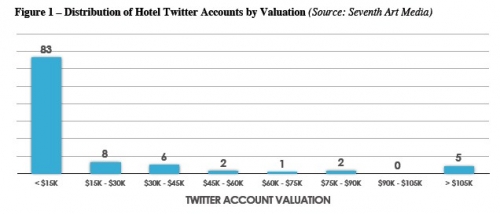
The results show that 83 out of the 107 accounts have a valuation of less than $15,000 (Figure 1) - the median value is only $3,941. The focus then turns to the ones that have created value and how they are different from the lower tiers.
Figure 2 lists the top 20 accounts in our study by value. While the top tier is dominated by hotel casinos and hotel brands, we see that some property-specific Twitter accounts have also built out a valuable asset. In just a few months' time, the newly launched Cosmopolitan Hotel & Casino in Las Vegas has created the most valuable hotel Twitter account among all those studied*. The highest valuation for an independent hotel's Twitter account is the Roger Smith Hotel in New York City.
In both cases, these accounts have lower followings than some of their direct competition but by focusing on engagement and building quality follower bases they have created far more value. So the question is clearly not “how many followers do I need?” but “how do I get the right followers?”
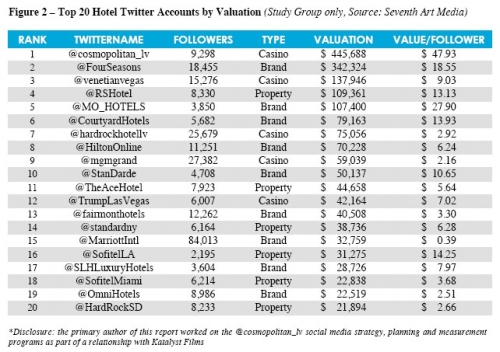
How to Create Value
Figure 3 illustrates the importance of engagement compared to pushing content. The four columns show the percentage of an account's tweets by type: replies, retweets, plain tweets, and tweets with links. The vertical position illustrates the potential network reach of the account (i.e. followers plus the followers of followers). The higher the position on the y-axis the more potential reach the account has to gain exposures. The size of each circle represents the valuation of the account.
If the entire world worked in a linear fashion - where more followers would equal more value - we would expect to see the largest circles at the top and the smallest at the bottom. Instead we see them spread across the spectrum. However, there are significant patterns within the data, which reveal important differences in how high-value accounts use Twitter compared to everyone else.
The red oval highlights a number of highly valued accounts with relatively smaller network reach. What is revealing is the movement of this group when we look at various tweet types. In the first column we see that 50% or more of the highly valued accounts' tweet volume is made up entirely of replies.
Moving to the next column we see that retweets are a much smaller percentage of their content. In the last column we highlight the relative under-performers in the black oval. These are all low value accounts with significant reach. The commonality among them is that they have a high relative volume of tweets with links. In other words, they aren't really engaging with their audience. These are huge lost opportunities for well-established hotel brands with large followings built upon brand recognition.
Hotel brands cannot simply expect people will sign up and value their content. The content needs to connect, and in the world of Twitter that means one thing: engagement.
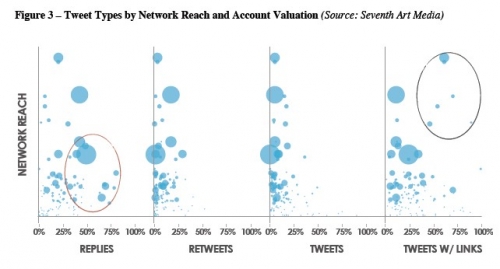
Our initial reaction was that some of these Twitter accounts may be focused entirely on conversions and that the links represent deals and calls-to-action promoted through the account. To a small extent this is the case but it doesn't entirely paint the picture.
By examining click-throughs on many of these links we were able to see that conversion rates were minimal for the large-network under-performers. A qualitative review of the content further illustrated a somewhat tone-deaf, corporate-speak approach to Twitter. Again, this underscores that if you aren't engaged then you really aren't listening. And if you aren't listening you really will not understand what is driving guest behavior on Twitter.
Managing the Asset
When we set forth to create this whitepaper it was an entirely exploratory process. Creating a valuation methodology specifically designed for the hotel industry was not the goal, but it was an outcome we could not ignore. Our method goes so far in summarizing many fundamental performance aspects of Twitter that it will become part of our toolbox for the foreseeable future.
We also explored many other facets of performance and metrics to help develop the overall picture. While tweeting style and voice are important, there are also some other factors that have effects on performance. Chief among these in our mind is a Twitter account's (over-)use of Facebook content.
Facebook and Twitter both exist because they are different animals and they can work in very complementary ways, but what is good for Facebook is not necessarily good for Twitter.
Figure 4 plots the percentage of tweets that are Facebook links or content posted directly via Facebook relative to the valuation of the Twitter account. The blue trend line (p=0.04) clearly illustrates: the lower the percentage of Facebook content cross-posted to Twitter, the better.
No further aspects of Twitter content revealed themselves as good predictors of either success or failure. This also extends to the operational aspect of Twitter management. Many valuable accounts still use Twitter's own website as their primary tool for managing their account and the use of HootSuite, TweetDeck, CoTweet or any other Twitter clients does not correlate with outcomes of any type. A hotel's decision of which Twitter client to use should be one of style and features. In fact, over 90% of accounts even use more than one platform—usually Twitter's direct website and one of the major Twitter clients, but many accounts indicate that administrators are still actively experimenting.
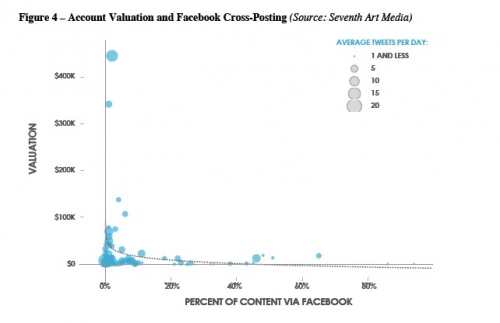
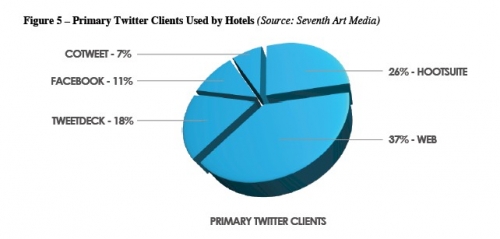
Valuation Versus Klout
How does our assessment differ from Klout or PeerIndex? In many respects the same factors that lead to a higher Klout or PeerIndex score also lead to a higher valuation. However, the nuances of interacting with hotel guests and the more limited scope of a single property's network limit the applicability of Klout in particular. Most importantly, Klout benchmarks its score against all Twitter accounts, so an industry-specific adjustment needs to be taken into account. For example, our two highest rated accounts in this study showed a Klout score of 67. Using Klout as a reference point might suggest to an account owner with a Klout score in the mid-50s that they are not far from the leaders. However, this may not be the case.
Figure 6 compares our Twitter channel valuations with both Klout and PeerIndex scores. Klout does a much better job showing the relative positive growth across percentiles but it misses the threshold point at which valuation rapidly accelerates and creates a significant gap between top and bottom performers.
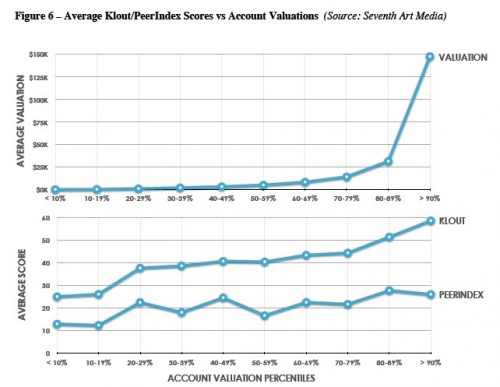
A closer look at the Klout score of @cosmopolitan_lv further supports the point that Klout scores miss the value proposition for hotels. The value of the @cosmopolitan_lv account has soared during the month of January as its following, buzz and network reach all rapidly increased (the hotel officially opened on December 31) but the Klout score has remained relatively stable. If the network reach and interaction continue on the same growth trajectory with quality followers, then it will continue to grow exponentially. However, the Klout score looks to have plateaued somewhat even though the value trajectory is quite high.
The Path to Success
Our research uncovered the key success factors, which drive the value of the highest performing Twitter accounts as well as the 'sins' of lesser performers. What underlies all successes is apparent: Each high-value account has a visible commitment to building a marketing asset via Twitter. For your hotel brand or property, this means that your competition is figuring it out. If you don't engage or commit to doing it the right way, you will look bad.
Part One: Overcoming Internal Resistance, Apathy and Misconceptions
One common obstacle for many of us to overcome is that the vagaries of Twitter often don't reveal themselves until we are fully immersed in it. Trying to explain the issues to non-users creates confusion, intimidation, or both. It doesn't have to be this way. By focusing on delivery of a tangible marketing asset with a definable value beyond metrics such as Klout score, followers and mentions, we can take the use of Twitter from the realm of “what-is-it?” to “must-have it.”
The remaining obstacle is the question of “How are we going to do it?” Hotel management teams are often intimidated or confused by the numbers that are used to promote social media. Therefore, it is important to put goals and activities into a bottom-line context and not just a media-centric context. It is more compelling to hear about a potential annual marketing value of $250k than to just focus on 15k followers or dozens of messages and mentions such a Twitter account might deliver on a daily basis.
Another reason to shy from media-centric measures is that they are difficult to put into perspective for the uninitiated. For example, citing Ashton Kutcher's (@aplusk) 6+ million followers puts Twitter into the realm of the unattainable and the unmanageable. Even citing the achievable goal of 15k followers can raise red flags on the organizational burden of such an account. The possibility of delivering a highly valuable marketing asset on the other hand should get full attention.
Part Two: Commit and Follow Through
Once you are in it - you stick with it. Creating a high-performing Twitter account requires committed engagement and follow-through with the network. This isn't as hard as it sounds. Hotel brands and properties can drive the conversation, but it must be relevant and designed to attract and retain a high-value following that cares more about your brand than discounts.
Copy-cat with discretion - many hyped Twitter accounts don't really perform. Unless you can specifically point to outcomes that are equal or similar to you goals, the fit simply might not be there. A good rule of thumb to remember is that if someone is hyping an account's potential then they are just speculating and the historical track record is littered with bad predictions on the performance of hyped accounts.
A Twitter account should never be in the hands of a single person. Ever. Just as a hotel itself will have layers of support for dealing with issues, you will also need a least one back-up for managing the account. We anecdotally know that many dead accounts, or the hyped accounts that didn't perform up to their potential, were victims of an employee departure. In some instances it may be both operationally prudent and economically wise to outsource management of your account to a capable agency or community management team.
Part Three: Earn Your Way to the Top
The only way you are going to get high engagement scores is by doing the work to earn them. This means being responsive and knowledgeable as well as respectful to the people you are engaging with via Twitter. Avoid the temptation to partake in quick ways to increase your followers on Twitter by jumping on a fad. You will be able to produce good follower numbers but they will almost all be worthless “hollow follows.”
Another temptation is to chase after influencers. It is nice to get their contribution to aid your cause but you cannot count on them for driving your amplification, and they certainly do not have an impact on how you engage with everyone else.
Identifying influencers and managing them is certainly important and we do not want to downplay their potential impact when you have the opportunity to bring them into the fold, but your long-term sustainability is going to come from a thousand small but committed influencers and not three or four big ones. In summary, commitment and organic growth will win the day.
Seventh Art Media is a division of Seventh Art Group, founded by David Williams and Michel Mein, with offices in New York, London and the Middle East. Seventh Art Media is specialized in social media content & strategy development for hotels, resorts, retail, and commercial real estate worldwide. We create value through branded experiences for hospitality, retail and real estate. Seventh Art Group's clients, including Starwood Hotels & Resorts, Four Seasons Hotels & Resorts, Ritz-Carlton, Plaza Hotel New York, The Related Companies, and many more, have entrusted us with 150 worldwide projects in 22 cities, 4 continents, worth US$7bn. Learn more about how we can help your hospitality or real estate brand at www.SeventhArtMedia.com www.twitter.com/seventhartmedia and www.facebook.com/seventhartmedia



 Marriott International, Inc. (NASDAQ: MAR) is a global leading lodging company based in Bethesda,Maryland, USA, with more than 4,200 properties in 80 countries and territories. Marriott International reported revenues of nearly $14 billion in fiscal year 2014. The company operates and franchises hotels and licenses vacation ownership resorts under 19 brands, including: The Ritz-Carlton®, BVlgari®, EDITION®, JW Marriott®, Autograph Collection® Hotels, Renaissance® Hotels, Marriott Hotels®, Delta Hotels and Resorts®, Marriott Executive Apartments®, Marriott Vacation Club®, Gaylord Hotels®, AC Hotels by Marriott®, Courtyard®, Residence Inn®, SpringHill Suites®, Fairfield Inn & Suites®, TownePlace Suites®, Protea Hotels® and MoxyHotels®. Marriott has been consistently recognized as a top employer and for its superior business ethics. The company also manages the award-winning guest loyalty program, Marriott Rewards® and The Ritz-Carlton Rewards® program, which together surpass 50 million members. For more information or reservations, please visit our website at
Marriott International, Inc. (NASDAQ: MAR) is a global leading lodging company based in Bethesda,Maryland, USA, with more than 4,200 properties in 80 countries and territories. Marriott International reported revenues of nearly $14 billion in fiscal year 2014. The company operates and franchises hotels and licenses vacation ownership resorts under 19 brands, including: The Ritz-Carlton®, BVlgari®, EDITION®, JW Marriott®, Autograph Collection® Hotels, Renaissance® Hotels, Marriott Hotels®, Delta Hotels and Resorts®, Marriott Executive Apartments®, Marriott Vacation Club®, Gaylord Hotels®, AC Hotels by Marriott®, Courtyard®, Residence Inn®, SpringHill Suites®, Fairfield Inn & Suites®, TownePlace Suites®, Protea Hotels® and MoxyHotels®. Marriott has been consistently recognized as a top employer and for its superior business ethics. The company also manages the award-winning guest loyalty program, Marriott Rewards® and The Ritz-Carlton Rewards® program, which together surpass 50 million members. For more information or reservations, please visit our website at 

